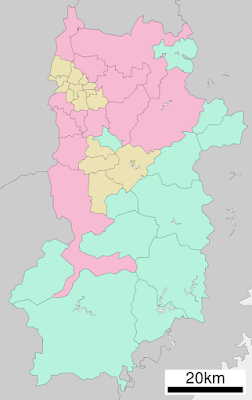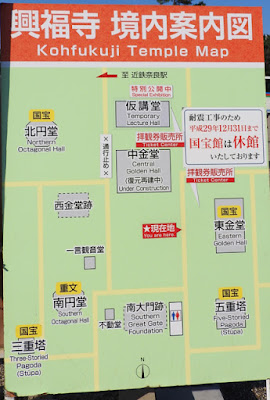目次 / Contents
1) 悠久の奈良・大和路めぐり / Eternal
Nara, Visit Yamatoji
2) 日程 /
Itinerary
3) 興福寺 / Kōfuku-ji
Temple
A. 三河安城駅 / Mikawa-Anjō
Station
B. 藤原氏の氏寺 / Fujiwara Clan's Temple
C. 東金堂 / Golden Hall
C. 東金堂 / Golden Hall
1) 悠久の奈良・大和路めぐり
Eternal
Nara, Visit Yamatoji
Rの誕生日は9月ですが、誕生日旅行は10月になってしまいました。
彼が奈良に一度も行ったことがなかったので、奈良を選びました。
Wikiで大和路の説明は下のようにあります。
この旅行では、京都へは行かず、奈良県内のみで、殆どが奈良市内の観光でした。
なお、"古都奈良の文化財" は、下記の8つで、ツアーに含まれているものは太字表示の5つです。
興福寺 (★)
春日大社 (★)
薬師寺 (★)
平城宮跡 (■)
 |
 |
 |
濃いピンク:奈良市
観光先は奈良市、もしくはその近郊でした。
Deep Pink : Nara City
The
sightseeing destination was Nara city, or its vicinity.
画像は下記より/
This from below
|
Eternal
Nara, Visit Yamatoji
R's
birthday is in September, but we had his birthday trip in October.
Since
he had never been to Nara, we chose Nara and in the old days it was
called Yamato, and also called Heijo
Kyo .
Nara is the historic place name which is regarded as the origin of Japan as one country.
According to Wiki about Heijo Kyo,
"Heijō-kyō (平城京,
also Heizei-kyō,
sometimes Nara
no miyako),
was the capital city
of Japan during
most of the Nara
period, from 710–40 and again from 745–84. The imperial
palace is a listed UNESCO
World Heritage together with other places in the city
of Nara (cf. Historic
Monuments of Ancient Nara)."
We
joined the tour by Club
Tourism International Inc., the tour plan : "Eternal Nara, Three Days" : Visit the 7 designated World
Heritage (Cultural
Properties).
List of World Heritage Sites in Japan : ★
List of World Heritage Sites in Japan : ★
Historic
Monuments of Ancient Nara, of the 8 below the 5 in bold
characters are
in our tour.
Tōdai-ji Temple,
Kōfuku-ji Temple,
Yakushi-ji Temple,
2) 日程 / Itinerary
日程は下記ですが、実際は、全部を訪れることは、私とRにはできませんでした。
ツアーは、私達には忙しすぎて、何かを諦めることは、しばしばあります。
Our Itinerary is
below, but in fact, I and R were not able to visit
everything.
Tours are too busy for us, and we often give up something.
26日 /
26th
東大寺大仏殿 (拝観)
/ Great Buddha
Hall of Tōdai-ji
Temple
東大寺二月堂 (拝観)
/ Nigatsu-dō of Tōdai-ji
Temple
春日大社 (社殿参拝)
/ Kasuga-
Taisha : Kasuga
Grand Shrine
27日 /
27th
法隆寺 (大宝蔵院拝殿)
/ Hōryū-ji Temple
室生寺 (金堂外陣特別拝観)
/ Murō-ji Temple
長谷寺 (拝観)
/ Hase-dera Temple
28日 /
28th
唐招提寺 (拝観)
/ Tōshōdai-ji Temple
薬師寺 (拝観 / 僧侶の法話拝聴)
/ Yakushi-ji Temple
橿原神宮 (参拝)
/ KashiharaShrine
3) 興福寺 / Kōfuku-ji
Temple
A. 三河安城駅 / Mikawa-Anjō
Station
初めて、私は三河安城駅を利用しました。帰路時にも利用。
駅にベンチがなく、飲食店も早々と閉まり、新幹線の駅としては、ちょっと悲しい状態です。
ともかく、私達はそこから観光バスで、興福寺に向かいました。
(きっとこの方法はツ安くあがるのでしょう)
Mikawa-Anjō
Station
From Shinagawa Station,
we took the Shinkansen・Kodama and we alighted at Mikawa - Anjo Station.
This was the first time I had used Mikawa - Anjo Station.
Also we used here for our homeward journey.
Also we used here for our homeward journey.
There
is no seating at the station and the restaurant and the cafe are closed relatively early, considering this is a Shinkansen station it is a bit sad.
In
any case, we headed for Kōfuku-ji Temple by a coach
from there.
 |
| 複数の建物すべてを見る時間はツアーにはありません。 今回は、東金堂拝観がメインです。 The tour did not have time to show all the buildings. This time, Tō-kondō (Golden Hall) on the middle right was the main place. |
Fujiwara Clan's Temple
Kōfuku-ji
Temple is registered as a World Heritage Site as part of
"Historic
Monuments of Ancient Nara".
Official
Website : ★
The
origin of Kōfuku-ji
Temple is believed to be the Yamanashidera Temple founded in 699 by
Kagamino no Okimi (? -?) who was Fujiwara Kamatari (614 – 669)'s
legitimate wife.
The temple was moved to the present site along with the Heijo-kyo transition
capital of 710 and became Kōfuku-ji
Temple.
The
temple is Fujiwara Clan Temple, though the ideas for the construction of the main buildings came from the Emperor and the Empress.
About Fujiwara Family (Clan) →★
The construction work was directed by the Imperial Court, with a close relationship between the Fujiwara Clan and the Court.
The
temple was hit many times by fires and all the existing buildings date after the fires of the Genpei
War (1180 - 1185).
 |
左 : 東金堂 (国宝) / Left
: Golden Hall (National
Treasure)
右;五重塔 (国宝) /
Right : Five Storied Pagoda (National
Treasure)
現在の塔は、1426年に再建されたものです。
The
current tower was rebuilt in 1426.
|
C. 東金堂 / Golden Hall
東金堂は、薬師三尊のために、726年に創建されました。
1180年に火災にあい、現在の建物は、1415年に再建されたものです。
1187年、興福寺の僧兵は飛鳥の山田寺(奈良県桜井市) 講堂本尊の薬師三尊像を強奪し、東金堂本尊に据えましたが、1411年に東金堂と共に被災し、現在の銅造薬師如来像が、1415年頃に制作されました。
1937年に、現在の銅造薬師如来像の台座下から、1411年の被災を免れた、685年制作、山田寺の薬師如来像の頭部 [ (国宝) : ★ (画像)] が発見されました。
通常、この頭部は、国宝館(中金堂・チュウコンドウ) に展示されていますが、私達が訪ねたときは、国宝館 が耐震工事のために休館でしたので、東金堂の右隅に展示されていました : ★ (画像)。
東金堂内には下記の仏像が安置されています。
1180年に火災にあい、現在の建物は、1415年に再建されたものです。
1187年、興福寺の僧兵は飛鳥の山田寺(奈良県桜井市) 講堂本尊の薬師三尊像を強奪し、東金堂本尊に据えましたが、1411年に東金堂と共に被災し、現在の銅造薬師如来像が、1415年頃に制作されました。
1937年に、現在の銅造薬師如来像の台座下から、1411年の被災を免れた、685年制作、山田寺の薬師如来像の頭部 [ (国宝) : ★ (画像)] が発見されました。
通常、この頭部は、国宝館(中金堂・チュウコンドウ) に展示されていますが、私達が訪ねたときは、国宝館 が耐震工事のために休館でしたので、東金堂の右隅に展示されていました : ★ (画像)。
東金堂内には下記の仏像が安置されています。
1) 本尊、銅造薬師如来像 (ドウゾウ ヤクシニョライ ゾウ) (重要文化財) : ★ (画像)
土形原型による鋳銅造です。土形原型の手間を思うと、作った人々の意気込みが感じられます。
制作は室町時代 (1336 - 1573)。
土形原型による鋳銅造です。土形原型の手間を思うと、作った人々の意気込みが感じられます。
制作は室町時代 (1336 - 1573)。
2) 銅像日光・月光菩薩像(ドウゾウ ニッコウ・ゲッコウボサツ ゾウ) (重要文化財) : ★ (画像)
両像は、薬師如来を補佐する役目で、本尊の両脇に配置されています。
制作は白鳳(飛鳥)時代 (592 -710)。
両像は、薬師如来を補佐する役目で、本尊の両脇に配置されています。
制作は白鳳(飛鳥)時代 (592 -710)。
5) 木造四天王立像 (モクゾウ シテンノウ リュウゾウ) (国宝) : ★ (画像)
四方に置かれる四天王立像。
一本造:頭上から足下の邪鬼 (ジャキ)、台座 (ダイザ)まで1木のヒノキ材で作られています。
制作は平安時代 (794 -1185)。
四方に置かれる四天王立像。
一本造:頭上から足下の邪鬼 (ジャキ)、台座 (ダイザ)まで1木のヒノキ材で作られています。
制作は平安時代 (794 -1185)。
 |
東金堂内
東金堂内は撮影禁止。この写真は日本語のWikiのものです。
Inside
of Golden Hall
Golden Hall is
not allowed to photograph.
This
is from Wiki in
Japanese.

こちらの写真は英語版Wikiから。
This is from Wiki in English.
|
Golden Hall
Golden Hall (Tō-kondō) was founded for the Yakushi Sanzon : three gods : Yakushi Nyorai and the Bodhisattvas Nikko and Gakko in 726.
After they had fire in 1180, the current building was rebuilt in 1415.
In 1187, the monks of Kofukuji robbed the Statue of Yakushi Nyorai from Yamada Temple of Asuka (Sakurai City, Nara Prefecture) and set it here, however, when the hall had a fire in 1411, the statue was lost as well, so the current statue was made in around 1415.
In 1937, inside the pedestal of the current Statue of Yakushi Nyorai they found the head of the original Yakushi Nyorai from 685 which had come from the Yamada Temple and was saved from fire in 1411.
Normally the head is displayed in the Central Golden Hall : Chū-kondō, though when we visited, the Central Golden Hall undergoing earthquake-proof strengthening, so they displayed it in the right hand corner of the Golden Hall : Tō-kondō.
Inside are statues below,
After they had fire in 1180, the current building was rebuilt in 1415.
In 1187, the monks of Kofukuji robbed the Statue of Yakushi Nyorai from Yamada Temple of Asuka (Sakurai City, Nara Prefecture) and set it here, however, when the hall had a fire in 1411, the statue was lost as well, so the current statue was made in around 1415.
In 1937, inside the pedestal of the current Statue of Yakushi Nyorai they found the head of the original Yakushi Nyorai from 685 which had come from the Yamada Temple and was saved from fire in 1411.
Normally the head is displayed in the Central Golden Hall : Chū-kondō, though when we visited, the Central Golden Hall undergoing earthquake-proof strengthening, so they displayed it in the right hand corner of the Golden Hall : Tō-kondō.
Inside are statues below,
1) A copper-alloy statue of Yakushi Nyorai (the principal icon, and an Important Cultural Property) : ★ (Photograph)
It was made using clay moulding.
Considering the complicated technique, I feel the creators's enthusiasm.
Created in Muromachi Period (1336 - 1573).
2) Copper-alloy statues of the Bodhisattvas Nikko and Gakko (Suryaprabha and Candraprabha, both Important Cultural Properties) : ★ (Photograph)
Both statues serve as supporters of Yakushi Nyorai and are located on both sides of the main statue.
Created in Asuka Period (592 -710).
3) A wooden statue of Monju Bosatsu : ★ (Photograph)
Monju Bosatu is symbolizing wisdom, located on the right side of the main statue.
Created in Kamakura Period (1185 or 1192 -1333)
4) A wooden statue of Yuima Koji (Manjusri Bodhisattva and the Layman Vimalakirti ,
both National Treasures) : ★ (Photograph)
A rich Indian man, Vimalakirti : Yuima Koji who has been regarded as a model for Buddhists for a long time.
Created in Kamakura Period (1185 or 1192 -1333)
5) Wooden statues of the Four Heavenly Kings : ★ (Photograph)
Standing Four Heavenly Kings statues placed in the four corners.
Making from one trunk : they were made of one trunk of Japanese cypress wood, from overhead to feet ; Oni ; devil and pedestal.
Created in Heian Period (794 -1185).
6) Wooden statues of the Twelve Divine Generals (National Treasures) : ★ (Photograph)
They are the guardian gods of Yakushi Nyorai and 6 statues are arranged on either side of the main statue.
Created in Kamakura Period (1185 or 1192 -1333)
It was made using clay moulding.
Considering the complicated technique, I feel the creators's enthusiasm.
Created in Muromachi Period (1336 - 1573).
2) Copper-alloy statues of the Bodhisattvas Nikko and Gakko (Suryaprabha and Candraprabha, both Important Cultural Properties) : ★ (Photograph)
Both statues serve as supporters of Yakushi Nyorai and are located on both sides of the main statue.
Created in Asuka Period (592 -710).
3) A wooden statue of Monju Bosatsu : ★ (Photograph)
Monju Bosatu is symbolizing wisdom, located on the right side of the main statue.
Created in Kamakura Period (1185 or 1192 -1333)
4) A wooden statue of Yuima Koji (Manjusri Bodhisattva and the Layman Vimalakirti ,
both National Treasures) : ★ (Photograph)
A rich Indian man, Vimalakirti : Yuima Koji who has been regarded as a model for Buddhists for a long time.
Created in Kamakura Period (1185 or 1192 -1333)
5) Wooden statues of the Four Heavenly Kings : ★ (Photograph)
Standing Four Heavenly Kings statues placed in the four corners.
Making from one trunk : they were made of one trunk of Japanese cypress wood, from overhead to feet ; Oni ; devil and pedestal.
Created in Heian Period (794 -1185).
6) Wooden statues of the Twelve Divine Generals (National Treasures) : ★ (Photograph)
They are the guardian gods of Yakushi Nyorai and 6 statues are arranged on either side of the main statue.
Created in Kamakura Period (1185 or 1192 -1333)
 |
| 仮講堂で / In Temporary Auditorium |
仮講堂で阿修羅像、他数点を展示しているようでしたが、私達は拝観しませんでした。
もともと時間がないツアーでしたし、阿修羅は過去に3回ほど見ていたので。
Rは見ていませんが、彼は忙しさを悪化させてまでの興味はないのでした。
 |
| 阿修羅 / Asura 画像は下記より / This from below ★ |
It
seemed that the Asura statue at the temporary auditorium, and several
others were on display, but we did not go.
Because basically, it was that the tour did not have enough time for looking at all sightseeing places and that I had already seen the Asura statue three times.
R hasn't seen it, although he was not interested in the statue as he felt busy enough.

阿修羅像(国宝) / Asura Statue (National Treasures)
画像は下記より / This from below
★ |
興福寺の後は、東大寺に行きました。
次のセクションが東大寺についてです。
After
Kofukuji, I went to Todaiji.
The
next section is about Todaiji.




